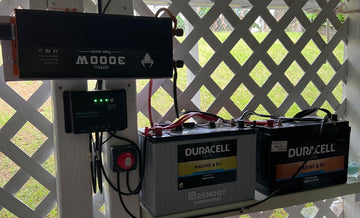Against the backdrop of today's global climate challenges and energy transition, solar energy as a renewable energy source is receiving increasing attention and application. With the continuous innovation of solar power generation technology and the gradual reduction of costs, more and more countries and regions are actively adopting solar power as a major energy source. Solar power generation occupies an important position in global renewable energy. According to a report by SEIA (Solar Energy Industries Association), more than 200 gigawatts (GW) of solar power capacity has been installed in the US, enough to power more than 36 million homes.
Among solar power technologies, solar shingles and solar panels are two popular choices.
What are Solar Shingles?

Solar shingles (which look like regular roof tiles) contain solar cells and are an innovative solar technology. It combines the functionality of traditional roofing materials with solar power generation. Unlike traditional solar panels, which are usually installed on top of an existing roof, solar shingles can be seamlessly integrated into the structure of the roof itself. Solar shingles come in a variety of styles and colors that homeowners can choose from based on their architectural design and personal preferences.
How Do Solar Shingles Work?
Solar shingles use thin-film photovoltaic cells or crystalline silicon solar cells that can convert sunlight into electricity. These solar cells are embedded or laminated into individual shingle units to form a roofing material similar to traditional asphalt or slate tiles. They work on the same basic principles as traditional solar panels but have the added advantage of being integrated into the structure of the roof itself.
Photovoltaic cells: Solar shingles are made up of individual tile units, each containing photovoltaic cells. These cells, usually made of thin-film solar material or crystalline silicon, are capable of converting sunlight into electricity.
Sunlight absorption: When sunlight strikes the surface of solar shingles, the photovoltaic cell absorbs photons (light particles) from the sunlight. This process creates an electric field in the layers of the solar cell.
Electrons move: The absorbed photons excite the electrons in the PV cell, causing them to move and generate an electric current.
Electrical output: The electricity produced by the solar shingles is a direct current (DC). To make it compatible with the standard alternating current (AC) used in homes and businesses, an inverter is usually installed to convert the DC into AC.
Power consumption: The electricity generated can be used to power a wide range of electrical equipment and appliances within a building. It can power lighting, heating, cooling, electronics, and other energy needs. If the solar tile produces more electricity than is currently needed, the excess can be stored in batteries for later use or fed back into the grid.
The overall operation of a solar tile is similar to that of a traditional solar panel, but the main difference is the integration into the roof. By replacing or covering traditional roofing materials, solar tiles perform the dual function of protecting the building from the elements and generating electricity.
Read More: How Do Solar Panels Work?
Both solar panels and solar tiles can provide significant energy savings and financial returns, but how do you choose?
Pros and Cons of Solar Panels
Pros:
- Solar panels are the most common solar power technology on the market, with proven technology and extensive application experience.
- Conventional solar panels typically have high conversion efficiencies, allowing for more efficient conversion of solar energy into electricity.
- Solar panels typically have low installation costs and are suitable for solar projects of all sizes.
Cons:
Appearance limitations: solar panels may not be flexible enough in terms of appearance and require special installation and design to integrate into a building.
Pros and Cons of Solar Shingles
Here are the main pros and cons of solar shingles
Pros:
- Streamlined appearance is very similar to traditional shingles, providing greater visual appeal and an integrated look
- They are less likely to cause roof leaks than rack-mounted panels
- Solar shingles come in a variety of styles, colors, and designs
Cons:
- Solar shingles cost two to three times more than solar panels.
- Solar shingles typically have a lower energy conversion efficiency compared to traditional solar panels
- Installing solar shingles is more complicated and requires specialized skills and expertise
- Solar shingle manufacturers and installers may have fewer options to choose from
Comparing Solar Shingles vs. Solar Panels
When considering a solar energy system, it is necessary to understand the differences between solar shingles and traditional solar panels. They can help you decide which one is better for your home.
Aesthetics
Many people consider solar shingles to be more stylish than solar panels. They fit snugly on the roof like regular shingles and blend in perfectly with most dark-colored roofs, whereas solar panels may require an entire roof rack system. In comparison, traditional solar panels look out of place.
If you're concerned about the appearance of a solar installation, solar shingles are a better choice.
Efficiency
There is also a big difference in the efficiency of solar shingles compared to solar panels. Solar panels are more technologically advanced than solar shingles, with conventional solar panels achieving efficiencies of 15-22%, while solar shingles are only between 10 and 18% efficient. Recent advances in photovoltaic technology have yet to be incorporated into smaller, more flexible solar shingles.
In addition, solar panels can be angled and oriented to better capture sunlight. Solar shingles mounted on the roof surface, on the other hand, are not flexible and airflow underneath them is obstructed. The lack of airflow through the solar tiles prevents the heated solar shingles from cooling more quickly, reducing electrical efficiency. This is why there is such a large efficiency gap between them.
Installation and complexity
In terms of complexity, the installation of solar shingles requires specialized skills and expertise. The combination of solar technology and roofing materials adds to the complexity of the installation process and may require specialized roofers and electricians. Traditional solar panels, on the other hand, are relatively simple to install. They are mounted on brackets or frames, usually on an existing roof, and connected to the electrical system.
Solar shingles, on the other hand, are installed in the same way as ordinary shingles, using roofing nails with caps, so there is much less risk of damaging the roof or causing leaks. It performs two functions: generating renewable energy and protecting the home from the elements.
Durability
The durability of solar panels and shingles can be affected by a number of factors, including quality of manufacture, choice of materials, quality of installation, and the environment in which they are used. Solar panels can last 25 to 30 years at maximum energy output. In general, solar shingles can have a comparable or slightly shorter lifespan than solar panels. Solar shingles typically last between 20 and 25 years, depending on the quality of the product and the conditions in which it is used.
When purchasing solar products, it is advisable to choose reputable manufacturers and suppliers who offer warranties and after-sales services and follow proper installation and maintenance requirements.
Environmental impact
Both solar panels and solar shingles help protect the environment by generating renewable energy and reducing dependence on fossil fuels. However, the manufacturing and installation process has its environmental footprint. While traditional solar panels are efficient at producing energy, their materials and manufacturing process can be energy-intensive.
Roof-integrated solar shingles can reduce the need for additional roofing materials and, when used in place of traditional shingles, can reduce the overall environmental impact. However, the lower efficiency of solar shingles means that more material may be required to achieve the same energy output as solar panels, which may offset some of the benefits.
Cost
Solar tiles tend to be more expensive than traditional solar panels. The combination of solar technology and roofing materials increases manufacturing and installation costs. Traditional solar panels have been on the market longer and are therefore more competitive, offering economies of scale and a wider range of options.













